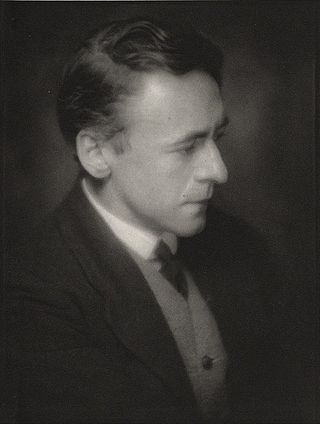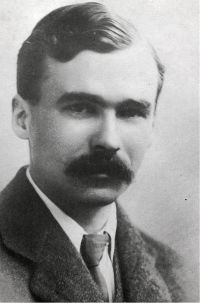
Alfred Edward Housman was an English classical scholar and poet. After an initially poor performance while at university, he took employment as a clerk in London and established his academic reputation by publishing as a private scholar at first. Later Housman was appointed Professor of Latin at University College London and then at the University of Cambridge. He is now acknowledged as one of the foremost classicists of his age and has been ranked as one of the greatest scholars at any time. His editions of Juvenal, Manilius, and Lucan are still considered authoritative.

Sir Arnold Edward Trevor Bax, was an English composer, poet, and author. His prolific output includes songs, choral music, chamber pieces, and solo piano works, but he is best known for his orchestral music. In addition to a series of symphonic poems, he wrote seven symphonies and was for a time widely regarded as the leading British symphonist.

George Sainton Kaye Butterworth, MC was an English composer who was best known for the orchestral idyll The Banks of Green Willow and his song settings of A. E. Housman's poems from A Shropshire Lad.

Ivor Bertie Gurney was an English poet and composer, particularly of songs. He was born and raised in Gloucester. He suffered from bipolar disorder through much of his life and spent his last 15 years in psychiatric hospitals. Critical evaluation of Gurney has been complicated by this, and also by the need to assess both his poetry and his music. Gurney himself thought of music as his true vocation: "The brighter visions brought music; the fainter verse".
A Shropshire Lad is a collection of sixty-three poems by the English poet Alfred Edward Housman, published in 1896. Selling slowly at first, it then rapidly grew in popularity, particularly among young readers. Composers began setting the poems to music less than ten years after their first appearance, and many parodists have satirised Housman's themes and poetic style.

Wenlock Edge is a limestone escarpment near Much Wenlock, Shropshire, England and a site of special scientific interest because of its geology. It is over 19 mi (31 km) long, running southwest to northeast between Craven Arms and Much Wenlock, and is roughly 1,083 feet above sea level. The deciduous woodland which runs along it covers much of the steep slopes of the escarpment and in parts it is very well preserved.
Green Ways is a set of three short atmospheric piano works composed by John Ireland in 1937, the individual titles are The Cherry Tree, Cypress and The Palm and May. They were written when the composer was 57, and are among the last pieces he wrote for piano.

Hodie is a cantata by Ralph Vaughan Williams. Composed between 1953 and 1954, it is the composer's last major choral-orchestral composition, and was premiered under his baton at Worcester Cathedral, as part of the Three Choirs Festival, on 8 September 1954. The piece is dedicated to Herbert Howells. The cantata, in 16 movements, is scored for chorus, boys' choir, organ and orchestra, and features tenor, baritone, and soprano soloists.
James Campbell McInnes was a well-known English baritone singer and teacher at the turn of the 20th century, ex-husband of author Angela Thirkell and father of writer Colin MacInnes.
"Is My Team Ploughing" is a poem by A. E. Housman, published as number XXVII in his 1896 collection A Shropshire Lad. It is a conversation between a dead man and his still living friend. Toward the end of the poem it is implied that the friend is now with the girl left behind when the narrator died. In writing the poem, Housman borrows from the simple style of traditional folk ballads, featuring a question-and-answer format in a conversation.
Charles Wilfred Leslie Orr, generally known as C. W. Orr, was an English composer.
The composition of art song in England and English-speaking countries has a long history, beginning with lute song in the late 16th century and continuing today.

When I Was One-and-Twenty is the first line of the untitled Poem XIII from A. E. Housman’s A Shropshire Lad (1896), but has often been anthologised and given musical settings under that title. The piece is simply worded but contains references to the now superseded coins guineas and crowns. It is the monologue of a young man of twenty-two who reflects on the truth of the advice given him a year before not to give his heart away in love. Writing to his publisher in December, 1920, Housman scornfully observed of an illustrated edition of the poem, “How like an artist to think that the speaker is a woman!” A heterosexual male reading could still be given the lament then because, at the time, Housman's homosexuality was unsuspected. Later the more likely interpretation of the poem's inspiration as referring to Housman's unrequited love for a fellow male student at university has gained currency.

On Wenlock Edge is a song cycle composed in 1909 by Ralph Vaughan Williams for tenor, piano and string quartet. The cycle comprises settings of six poems from A. E. Housman's 1896 collection A Shropshire Lad. A typical performance lasts around 22 minutes. It was premiered by Gervase Elwes, Frederick Kiddle and the Schwiller Quartet on 15 November 1909 in the Aeolian Hall, London. It was later orchestrated by the composer in a version first performed on 24 January 1924. Subsequent editions show a measure excised from the final movement (Clun): the third measure from the end. The Boosey and Hawkes 1946 score notes indicates this in a footnote on the last page. The cycle was recorded by Elwes, Kiddle and the London String Quartet in 1917.
Six Songs from A Shropshire Lad is a song cycle for baritone and piano composed in 1911 by George Butterworth (1885–1916). It consists of settings of six poems from A. E. Housman's 1896 collection A Shropshire Lad.
The Land of Lost Content is a song cycle for voice and piano composed in 1920–21 by John Ireland (1879–1962). It consists of settings of six poems by A. E. Housman from his 1896 collection A Shropshire Lad.
We'll to the Woods No More is a song cycle for voice and piano composed in 1928 by John Ireland. It consists of settings of two poems by A. E. Housman (1859–1936) and a concluding piece for solo piano named after a third.
After A. E. Housman’s death in 1936, his brother Laurence was made his literary executor and over the next two years published further selections of poems from his manuscripts: in 1936 More Poems and, between 1937-9, Additional Poems, although the latter were never printed as a separate edition. As much more of Housman's earlier writing was brought to light, its autobiographical nature clarified his suppressed homosexuality. There are also recognisable Classical influences.

The English Pastoral School, sometimes called the English Nationalist School or by detractors the Cow Pat School, is an informal designation for a group of English composers of classical music working during the early to mid 20th century, who sought to build a distinctively English style of music by composing in a style informed by Tudor music and English folk music, and often explicitly evoking the English countryside. The leading composers associated with the school were Ralph Vaughan Williams, Frederick Delius and Gustav Holst, with other notable figures including George Butterworth, John Ireland, Frank Bridge, Edmund Rubbra, Gerald Finzi, Herbert Howells, Ernest John Moeran and Peter Warlock.









